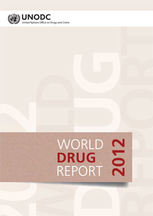World Drug Report 2012
The World Drug Report provides an overview of recent trends and the drug situation in terms of production, trafficking and consumption of illegal drugs. The 2012 edition concludes with both stability and worrying trends in the global drug scene.
The World Drug Report provides an overview of recent trends and the drug situation in terms of production, trafficking and consumption of illegal drugs. Furthermore, the report is an important source for information about the consequences of drug use in terms of treatment, drug-related diseases and drug-related deaths.
Latest available data indicate that there has been no significant change in the global status quo regarding the use, production and health consequences of illicit drugs, other than the return to high levels of opium production in Afghanistan after a disease of the opium poppy and subsequent crop failure in 2010. But while the troubled waters of the world’s illicit drug markets may appear to be stagnant, shifts and changes in their flows and currents can be observed below the surface.
The executive summary from the publisher of the report, The United Nations Office on Drugs and Crime (UNODC), presents the following overall picture: The extent of global illicit drug use remained stable in the five years up to and including 2010, at between 3.4 and 6.6 per cent of the adult population (persons aged 15-64). However, some 10-13 per cent of drug users continue to be problem users with drug dependence and/or drug-use disorders. The prevalence of HIV (estimated at approximately 20 per cent), hepatitis C (46.7 per cent) and hepatitis B (14.6 per cent) among injecting drug users continues to add to the global burden of disease. Last but not least, approximately 1 in every 100 deaths among adults is attributed to illicit drug use.
The full text of The World Drug report 2012 can be downloaded here.
Here is the Executive Summary of the report.
In the report a comparison is made between the prevalence of legal and illegal substances:
- While illicit drug production, trafficking and use remain issues of concern, the international drug control system appears to have kept the consumption of illegal drugs well below the levels reported for legal psychoactive substances. Global estimates suggest that past-month prevalence of tobacco use (25 per cent of the population aged 15 and above) is 10 times higher than past-month prevalence of illicit drug use (2.5 per cent).
- Annual prevalence of the use of alcohol is 42 per cent (the use of alcohol being legal in most countries), which is eight times higher than annual prevalence of illicit drug use (5.0 per cent). Heavy episodic weekly drinking is eight times more prevalent than problem drug use.
- Drug use accounts for 0.9 per cent of all disability-adjusted life years lost at the global level, or 10 per cent of all life years lost as a result of the consumption of psychoactive substances (drugs, alcohol and tobacco).
Other points from executive summary are:
- Although established illicit drug markets in many developed countries have shown signs of stabilization, the growth of drug use seems to continue in many developing countries.
- The use of legal psychoactive substances tends to be far more homogeneously distributed across age groups than the use of illegal drugs.
- There is a pronounced gender gap in relation to illicit drug consumption, with use levels among females significantly lower than among males in nearly all countries for which solid gender-disaggregated data are available.
- There are some signs, however, that the gender gap may be diminishing in some highly mature illicit drug markets, particularly among young people.
RELATED ARTICLES
- Two weeks of drug policy discussions in Vienna
- Protection from illicit drugs – a child rights issue
- New Political Declaration and Action Plan for international drug control
- Agreement signed on alcohol and drug prevention in Malawi
- UNODC calls for a comprehensive approach to drug problems
- UNGASS 2009: UN review of international conventions on narcotic drugs
- UNODC: Significant and positive changes in world drugs markets
- A chequered year for drug control
- Alcohol and Drug Use among Street Children in Nepal

